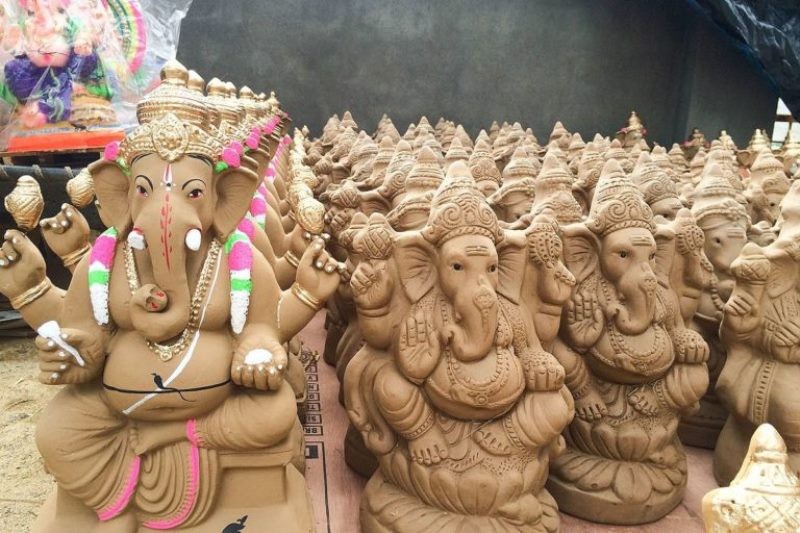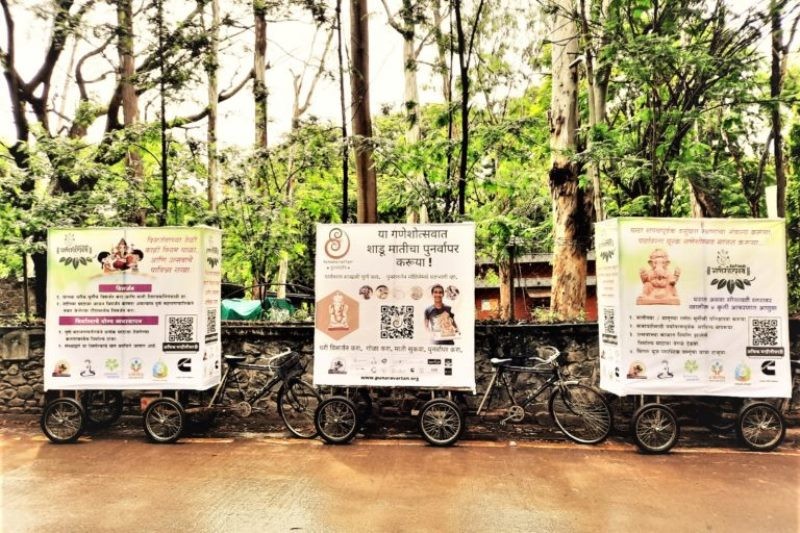 Recycling
An artist working on a Ganesha idol in Goa. A representative image. Nijgoykar/ Wikimedia Commons.
Recycling
An artist working on a Ganesha idol in Goa. A representative image. Nijgoykar/ Wikimedia Commons.
Eco-friendly Festivals: Pune recycles clay from Ganesha idols to minimise clay mining effect
A campaign initiated in Pune city collected 15,000 kilograms of clay sludge after the traditional immersion of Ganesh idols during the recent festival. This clay sludge will be used by idol makers for making new idols. Natural clay is a non-renewable material usually mined in states like Gujarat and West Bengal and brought to Maharashtra and other parts of India to make idols. Clay mining impacts both the environment and the health of the miners. Authorities in Pune are also reusing festival flowers and other religious wastes to make festivals more sustainable. Mongabay-India correspondent Manish Kumar reports
Dinesh Gole is an artisan working from Pen, a small town, around 110 kilometres away from Pune in Maharashtra, where he makes idols of the Hindu god Ganesha. These idols are Pen’s main claim to fame and they travel to several parts of India and even to other countries, especially during the Ganesh Chaturthi festival every September.
Gole makes around 1,500 Ganesha idols of different sizes every year which go to the bigger cities of Pune, Mumbai and Nashik in Maharashtra. He uses natural clay, locally known as shaadu maati, as the base to make these idols.
This core raw material of the idols made in Maharashtra, however, is often mined in other states and transported here during major festivals. “We receive the natural clay mainly from Gujarat, where it is mined. We buy it at a rate of around Rs. 150 for 35 kilograms of clay which comes in a packet,” says Gole.
Natural clay is a non-renewable, silicate mineral which is usually extracted from the ground by mining. West Bengal and Gujarat are the main states where clay is mined and then transported to Maharashtra and other parts of the country. The whole process – mining, extraction and transportation – is known to cause pollution and health hazards for those working in the mines, besides degrading the natural resources in the areas where the clay is mined.
Pune city, one of the main cities where these clay idols eventually land up, initiated the Punaravartan campaign this year, to minimise the impact of clay mining while celebrating the Ganesh festival. Voluntary organisations along with the Pune Municipal Corporation (PMC) came together to establish a system of collection of clay sludge after the immersion of the idol. This material will be recycled into idols for the next year.
The Punaravartan campaign aligns with the guidelines of the Central Pollution Control Board (CPCB) on using eco-friendly idols to prevent contamination of water bodies. The campaign collected 15,000 kilograms of clay – about the weight of two and a half adult elephants – from citizens, schools, societies and corporates in September 2022, when the Ganesh festival took place. This quantity of clay can be used to make about 15,000 new clay idols of one kilogram each, next year.
 As part of the campaign, the volunteers collected natural clay sludge from citizens to ensure its recycling and reuse. Photo from Punaravartan.
As part of the campaign, the volunteers collected natural clay sludge from citizens to ensure its recycling and reuse. Photo from Punaravartan.
“Natural clay is a perfect material to make idols. The clay particles are fine and have good adhesive quality. When immersed in water (a Ganesh festival tradition) the idols get dissolved within 10 minutes. This is unlike the Plaster of Paris (PoP) idols which take several months to degrade,” Gole told Mongabay-India.
PoP, another material which was commonly used for making the Ganesh idols, was cheaper and lighter than natural clay. It was slowly replacing natural clay as a material for the idols. But because of its environmental impact, especially on water bodies in which it was immersed, in 2020, the Central Pollution Control Board banned the use of PoP for making idols. PoP idols had chemicals like gypsum, sulphur, phosphorus, and magnesium and the dyes used in colouring had mercury, cadmium, arsenic, lead, and carbon – many of these have a harmful impact on the water bodies in which the idols are immersed and their associated ecosystem.
A city mobilises for an eco-friendly celebration
The preparations for the Punaravartan campaign started around June this year. There was a significant amount of awareness building and coordination among 15 voluntary organisations of the city.
Manisha Sheth, the founder of eCoexist, an environment organisation based in Pune, explained that efforts to recycle clay started in 2020, but it expanded and became bigger this year with the involvement of more people and organisations.
“We started this in 2020 on a small scale. We first experimented with some damaged idols to see the feasibility of recycling the clay and it worked very well. The artisans were also comfortable with the concept. We then planned to expand this and approached other environmental organisations and like-minded people. As clay is a non-renewable source, we wanted to minimise its usage. So we decided to recycle it,” Sheth told Mongabay-India.
In Pune, Sheth said, hundreds of thousands of Ganesha idols are immersed into water bodies every year. “Many organisations who had expertise in different subjects helped to give an impetus to this campaign with their strengths. Some were good at waste management, some at mobilising youth and some at strategies to ensure the good health of the city’s water bodies. So all of them contributed with their expertise and the campaign became big this year. We were able to collect around 15,000 kilograms of natural clay sludge that we returned to artisans for remaking idols,” she said.
Sathya Natarajan, a core member of the Plan Action Committee of Swachh Pune, Swachh Bharat, which works towards a clean, green and a garbage-free city, was responsible for the logistics of the Punaravartan campaign. The team had certain guidelines for clay collection from donors to ensure only natural clay and not any other mixed materials are being collected for recycling.
“We roped in several volunteers and set up around 50 collection centres in the city where the donors could submit their clay sludge for recycling. We also gave transportation services for big societies and communities. Other than collection points, we also collected the clay sludge from homes and in some cases, we collected entire idols and donated it to the artists for recycling. We shared video tutorials for awareness on how to make the sludge at home after doing the idol immersion at home,” Natarajan told Mongabay-India. The amount of recycled sludge collected this year can be used next year to make about 25 percent of the annual number of clay idols that an average, small-time artisan makes, notes Natarajan.
 The recycled sludge collected this year can be used next year to make idols. VedSutra/Wikimedia Commons.
The recycled sludge collected this year can be used next year to make idols. VedSutra/Wikimedia Commons.
The Pune Municipal Corporation (PMC) also set up its own collection centres to support the recycling of clay, he said.
Youth volunteers were a significant part of meeting the campaign’s ambition. Munira Phaltanwala, who worked to mobilise young people for the campaign, told Mongabay-India, “We went to colleges and talked to NGOs to mobilise the youth. Many college students came on board after hearing about the cause.”
The students were trained in the process and they then took the message forward either through directly working with communities and convincing them to donate the clay sludge for recycling, or through social networking sites where they created a buzz about the campaign, she explained. Phaltanwala is part of the Global Shapers Community, a youth network.
The Pune Municipal Corporation (PMC) too, in a notification issued before the Ganesh festival, endorsed the campaign. It urged the citizens of the city to switch to the eco-friendly idols and also take the help of voluntary organisations of the city to donate their used idols/sludge for recycling of the natural clay.
 The campaigners used cycle rallies and other modes of outreach programmes to spread the message of recycling clay. Photo from Punaravartan.
The campaigners used cycle rallies and other modes of outreach programmes to spread the message of recycling clay. Photo from Punaravartan.
Pune has a history of pro-environment action during festivals. Suchismita Pai, the co-founder of Social Seva Initiatives, a Pune-based non-profit, told Mongabay-India that before the campaign of recycling clay, several organisations, citizens and the PMC had previously collaborated to recycle the flowers used in festivals. Pai, who earlier worked with Swach, a waste management initiative, was also associated with the Punaravartan campaign this year.
“Recycling of clay was not the only work Pune saw in order to protect the environment. In 2011, eCoexist and Swach also worked together to start recycling of flowers and other religious wastes that were brought to the water bodies during festivals in Pune. The campaign was named ‘Nirmalya’. With the passage of time and more awareness, this also picked pace and we were able to recycle used flowers too. This year we were able to collect 77 tonnes of used flowers that were sent to the processing unit of PMC where it was converted into compost,” she said.
(Courtesy: Mongabay-India)
Top Headlines
-
News
Shashi Tharoor on guest list of Putin State dinner; Rahul Gandhi, Kharge not invited
December 05, 2025
-
News
Putin launches RT India Kremlin-funded RT Network's India arm with 100-member team
December 05, 2025
-
News
Inside Putin's India visit: You wont believe what's on the agenda!
December 04, 2025
-
News
Imminent threat: Marco Rubio warns against rise of radical Islam, announces US visa crackdown
December 04, 2025
-
News
You wont believe what Air India did to Anoushka Shankars sitar shes furious!
December 04, 2025
-
News
Bengal SIR shock: 1 lakh deceased voters found in Kolkata North!
December 03, 2025
-
News
Calcutta HC overturns controversial Bengal job annulment 32,000 teachers rejoice!
December 03, 2025
-
News
A Sonia Gandhi on the BJP ticket? Only in Munnar
December 02, 2025
-
News
Rahul Gandhis quip on pets in Parliament rekindles dog Row, BJP slams disrespect
December 02, 2025
-
News
Imran Khan mentally tortured, says sister after rare jail meeting amid rumour storm
December 02, 2025





